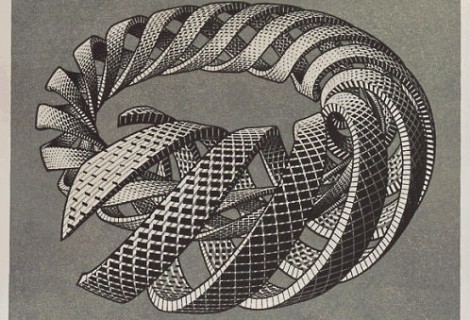Harmonic Points and Lines: A Projective Geometric Exercise
WARNING: PROJECTIVE GEOMETRY MAY PUT HOLES IN YOUR BRAIN. YOUR MIND MIGHT LEAK OUT – IF YOU WANT YOUR MIND IN YOUR BRAIN STOP READING NOW.
Okay, here is a geometric exercise that I find very interesting (for some context about WHY it is interesting, look here).
- It is, however, more complicated than the previous one and will likely require you to actually take out a pencil (not a pen, please, and go for mechanical – 0.5mm lead… do it for me), a ruler, and unlined paper.
HARMONIC POINTS – Phase 1
The short setup first, then construction hints, then process, then comments:
- Draw line a.
- Mark point A on line a.
- Draw two lines m and n through A.
- Mark point P on line a.
- Draw line p through P, meeting lines m and n in points C and D
- Mark point B on line a.
- Draw two lines, s and t, connecting B to points C and D.
- Note that s meets n in E and t meets m in F.
- Draw line q connecting E and F to line a in point Q.
- THAT’S IT. Everything else below this line you can discover for yourself if you but play…Note that every direction above relies solely upon properties of incidence and not in any way whatsoever on your choice of positioning – you are completely free to choose points and lines in any place or in any direction – even at infinity.Construction hints (if you need them):Because you may choose your elements with only the restrictions given above, you may find that your construction requires a larger (even infinitely large) piece of paper. To make your construction fit on the paper, you may want to try the following:
- Draw line a horizontally down the middle of your paper.
- Choose point A near the left side of a.
- Choose m and n so that they are at angles around 20ish and 45ish degrees clockwise from a (thus extending out below a on your paper)
- Choose P near the center of your paper on a.
- Draw line p so it meets m and n close to perpendicularly.
- Choose point B nearish point P but somewhat to its left.
- The rest is now determined.What you ‘end up with’ are four points, A, B, P, and Q, on line a.What is the relationship between these points, if any? Who cares? Who knows? Well, make your knowing happen by doing the following:On your present drawing, using your already chosen points A, B and P, repeat from step 3 above (if you followed my construction hints, now draw m and n counterclockwise from a, so they are above a).
You will note that the line connecting E and F will meet line a in the same point Q – in other words, point Q is not just a random point on line a but is somehow connected to the choice of the other three points A, B and Q. Hmmmmmmmm…. What might this mean? Why are you doing this? Is it clear to you that once you choose any three points on a line you have INEVITABLY chosen (inadvertently perhaps, but chosen nevertheless) a unique fourth point? Do you now make the distinction that the three points distinguish a fourth? Do you care that this relationship has been named, and that points in such a relationship are called harmonic to each other? In particular that A and B are harmonic conjugates of each other with respect to P and Q (and vice versa)?
(Side construction 1: Note that points C, D, E, and F form a quadrilateral CEDF. Having done the construction twice, you have two quadrilaterals. Are THESE related in any way?Connect with lines any three of the pairs of points from each quadrilateral: for example C to C, D to D, and F to F…. Note what happens to these three new lines…)
Is this boring you? Are you confused about why you are spending all this time doing geometry? Do you think you are going to ‘get’ something out of this?
Side construction 2:
Choose point O not on line a (try near the edge of your paper). Connect O to A, B, P and Q in four new lines. Draw any new line o, noting that it cuts the four new lines in four points, which you can call A’, B’, P’, and Q’. Are these four points harmonic to each other? Find out by repeating from step 3 above… Does your last line drawn connecting E’ and F’ meet point Q on line a?
What does this mean? Are you getting a sense that in choosing your initial three points on your first line a that you actually defined MUCH more – infinitely more – than just a fourth point Q? Do you sense that the WHOLE SPACE of your paper (indeed, the whole infinite plane of your infinitely extended paper) has been organized AT EVERY POINT with respect to your initial distinction of A, B and P? Do you see how there are an infinite number of equivalent harmonic ratios thus described?
Tangent: (i.e. further down the rabbit hole)
Measure AP (the distance between A and P), BP, AQ, and BQ.
Note the two ratios of AP/BP and AQ/BQ.
Note that these two ratios are equivalent… regardless of, for example, which new line o you draw!
What does this mean? That there is something specific (even measurable) that is invariant about the ratios between these four points? This invariant is a second-order process, a ratio of ratios. It is called the cross ratio.
Process:
Once you have found a nice resting place on line a for points A and B, let them stay there. But now we are going to let point P wander around, and because the original stipulation is that point P lies on line a, it must continue to do so; however it can move anywhere on line a that we want it to.
Up to this point you have only constructed one single fact of relations… from a certain perspective. Now we begin to get into the thick of things… Your task, should you choose to accept it, is to discover what happens when you put the relations into movement by sliding P along a. What happens to the fourth point Q? You will probably need to make some more constructions to see what happens…
Tips:
- Keep your initial points A and B constant, and vary point P, doing the construction to see what happens to point Q.
- Make sure that you place P to the ‘outside’ of the space between A and B as well as ‘between’ A and B. (Why did I have to put ‘outside’ and ‘inside’ in quotes?)
- What happens when P is coincident with A? With B?
- Make sure you see what happens when point P moves to infinity along line a. Once you have this relationship of relationships in your head, imagine the whole situation in its essence, without the construction – i.e. imagine the harmonic points A, B and P, Q on a line without anything else. Now move point P along the line in one direction, through infinity, and back from the other side to its original place, all the while watching what happens with point Q. Now imagine point P moving the other way, through infinity, back from the other side to it’s starting point.Dissolve the construction in your imagination but not the relationships.
Okay okay… if you need drawings to help you out, you can find them here.
Now we can discuss, if you wish, the metaphorical nature of this relationship of relationships…






Trackbacks for this post